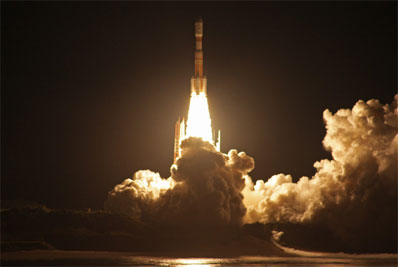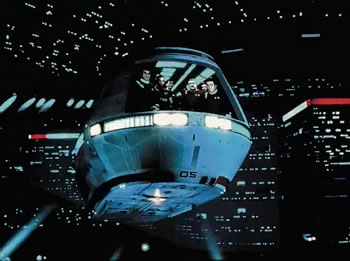Science Fiction
Dictionary
A B C D E F G H I J K L M N O P Q R S T U V W X Y Z
H-II Transfer Vehicle Automated Freighter

Japan's H-II Transfer Vehicle (HTV) successfully blasted off from the island of Tanegashima, south of Japan. This unmanned freighter carries 4.5 tons of equipment and supplies to the International Space Station; its maximum capacity is 6 tons.

(HTV lift-off)
The 35,000-pound H-2 Transfer Vehicle was tucked inside the H-2B rocket, which also made its maiden flight, for liftoff at 1701:46 GMT (1:01:46 p.m. EDT; 2:01:46 a.m. Friday JST), a rare nighttime launch for Japan.A pair of hydrogen-burning first stage engines ignited a few seconds before liftoff, ramping up to full power before computers commanded four large solid rocket boosters to light.
Spewing more than 3 million pounds of thrust, the powerful launcher quickly sped away from Launch Pad No. 2 at the Tanegashima spaceport, flying southeast and piercing an enveloping deck of clouds less than 30 seconds later.
The strap-on motors burned out and separated as designed two minutes after liftoff, and the nearly 17-foot diameter widebody first stage completed its job around four minutes later.
Here's the idealized version of the H-II Transfer Vehicle mission; watch this HTV video.
One day, we may get to the point where these mundane transfers of supplies and personnel are routinely carried out by automated ships, like the automated shuttles in Star Trek movies.
(Star Trek crew enroute to Enterprise on fully automated shuttle)The idea of a space freighter can be found as early as 1932; see this reference to space freighter from The Space Rover by Edwin K. Sloat.
Via Space Flight Now.
Scroll down for more stories in the same category. (Story submitted 9/14/2009)
Follow this kind of news @Technovelgy.| Email | RSS | Blog It | Stumble | del.icio.us | Digg | Reddit |
Would you like to contribute a story tip? It's easy:
Get the URL of the story, and the related sf author, and add it here.Comment/Join discussion ( 0 )
Related News Stories - (" Space Tech ")
Will Space Stations Have Large Interior Spaces Again?
'They filed clumsily into the battleroom, like children in a swimming pool for the first time, clinging to the handholds along the side.' - Orson Scott Card, 1985.Reflect Orbital Offers 'Sunlight on Demand' And Light Pollution
'I don't have to tell you about the seven two-mile-diameter orbital mirrors...'Chrysalis Generation Ship to Alpha Centauri
'This was their world, their planet — this swift-traveling, yet seemingly moveless vessel.' - Nat Schachner, 1934The First Space Warship For Space Force
'Each of the electrical ships carried about twenty men...' - Garrett P. Serviss, 1898.
Technovelgy (that's tech-novel-gee!) is devoted to the creative science inventions and ideas of sf authors. Look for the Invention Category that interests you, the Glossary, the Invention Timeline, or see what's New.
Science Fiction
Timeline
1600-1899
1900-1939
1940's 1950's
1960's 1970's
1980's 1990's
2000's 2010's
Current News
The Zapata Air Scooter Would Be Great In A Science Fiction Story
'Betty's slapdash style.'
Thermostabilized Wet Meat Product (NASA Prototype)
There are no orbiting Michelin stars. Yet.
Could Crystal Batteries Generate Power For Centuries?
'Power could be compressed thus into an inch-square cube of what looked like blue-white ice'
India Ponders Always-On Smartphone Location Tracking
'It is necessary... for your own protection.'
Amazon Will Send You Heinlein's Knockdown Cabin
'It's so light that you can set it up in five minutes by yourself...'
Is It Time To Forbid Human Driving?
'Heavy penalties... were to be applied to any one found driving manually-controlled machines.'
Replace The Smartphone With A Connected Edge Node For AI Inference
'Buy a Little Dingbat... electropen, wrist watch, pocketphone, pocket radio, billfold ... all in one.'
Artificial Skin For Robots Is Coming Right Along
'... an elastic, tinted material that had all the feel and appearance of human flesh and epidermis.'
Robot Guard Dog On Duty
I might also be thinking of K-9 from Doctor Who.
Wearable Artificial Fabric Muscles
'It is remarkable that the long leverages of their machines are in most cases actuated by a sort of sham musculature...'
BrainBridge Concept Transplant Of Human Head Proposed
'Briquet’s head seemed to think that to find and attach a new body to her head was as easy as to fit and sew a new dress.'
Google's Nano Banana Pro Presents Handwritten Math Solutions
'...copy was turned out in a charming and entirely feminine handwriting.'
Edible Meat-Like Fungus Like Barbara Hambly's Slunch?
'It was almost unheard of for slunch to spread that fast...'
Sunday Robotics 'Memo' Bot Has Unique Training Glove
'He then started hand movements of definite pattern...'
Woman Marries Computer, Vonnegut's Dream Comes True
'Men are made of protoplasm... Lasts forever.'
Natural Gait With Prosthetic Connected To Nervous System
'The leg was to function, in a way, as a servo-mechanism operated by Larry’s brain...'

